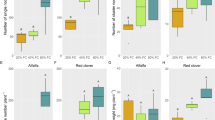Abstract
In a 2-year experiment at an open-air ozone fumigation field, the effects of fungicide application and low-level ozone exposure, single and combined, on fine root and mycorrhiza condition of Scots pine (Pinus sylvestris) seedlings were studied. Two different fungicides, copper oxychloride and propiconazole, with different modes of actions, were used. Propiconazole treatment reduced mycorrhizal infection in both years while copper oxychloride treatment and ozone exposure slightly stimulated mycorrhizal infection after the first year. Different mycorrhizal morphotypes showed different kinds of responses to the two fungicides. Light brown morphotype appeared to be the most sensitive one to propiconazole treatment. After the second year, ectendomycorrhizas disappeared in propiconazole treatment while in control treatment ectendomycorrhizas formed the majority of the light brown morphotype. The root biomass was not affected by fungicide treatments, but ozone exposure increased the total amount of short roots and the fresh weight of propiconazole treated roots. No significant differences in the concentrations of ergosterol, starch and total phenolics in pine roots between treatments were found. However, ergosterol concentration correlated positively with the mycorrhizal infection level. Both fungicides reduced the soil respiration compared to controls. At the ultrastructural level, both fungicides caused increased transparency and gradual granulation and degeneration of cytoplasm in the fungal symbiont of mycorrhizal short roots. Slightly elevated ozone did not have harmful effects on root ultrastructure. These results suggest that fungicides have deleterious effects on the quantity and quality of mycorrhizas in Scots pine roots and also side-effects on non-target soil fungi. Some of these deleterious effects were noticeable only at the ultrastructural level.
Similar content being viewed by others
Author information
Authors and Affiliations
Additional information
Received: 23 June 1997 / Accepted: 11 December 1997
Rights and permissions
About this article
Cite this article
Manninen, AM., Laatikainen, T. & Holopainen, T. Condition of Scots pine fine roots and mycorrhiza after fungicide application and low-level ozone exposure in a 2-year field experiment. Trees 12, 347–355 (1998). https://doi.org/10.1007/s004680050161
Issue Date:
DOI: https://doi.org/10.1007/s004680050161




